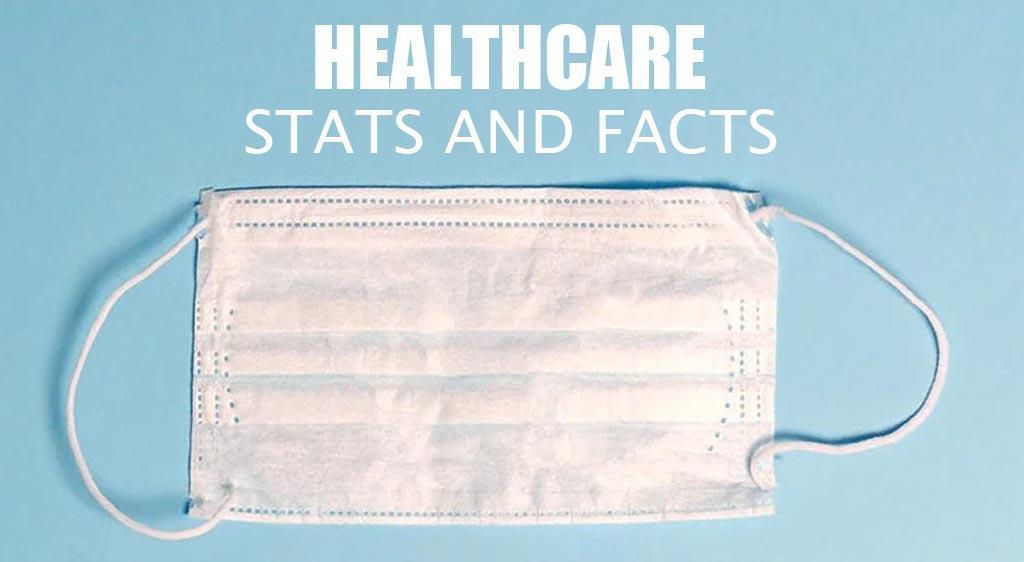Healthcare Statistics
The World Health Organization (WHO) affirms that the “enjoyment of the highest attainable standard of health is one of the fundamental rights of every human being without distinction of race, religion, political belief, economic or social condition.” Besides keeping our body strong and alive, there are other pragmatic reasons we, especially our governments should prioritize health. Health maintains society. When people are sick, they become unproductive and unhappy. Moreover, if the illness is severe, other people, whether they are loved ones or healthcare workers, must focus more of their attention on the sick and less on themselves and other. Thus, a nation enveloped by a disease can bring down both the economy and morale. The recent COVID-19 pandemic shows that. However, even with our advancements in ethics, philosophy, and science, we still have lapses in our healthcare systems, of which COVID-19 is taking full advantage.
(World Health Organization)
Most Surprising Healthcare Statistics
- Between 1950 and 2017, there was a great rise in life expectancy:
- Males: From 48 years to 71 years
- Females: From 53 years to 76 years
- Monaco has the highest life expectancy, which is an average of nearly 90 years per person.
- Life expectancy at birth in low-income countries is 18.1 years lower than in high-income countries.
- More than 40% of all deaths in children under 5 years of age occur during the neonatal period.
- From 2000 to 2017, the global maternal mortality per 100,000 live births declined by 38%.
- Cardiovascular diseases are the number 1 cause of death in the world.
- In 2019, more than 23% of children had stunted growth.
- At least 50% of the world has no access to essential healthcare.
(Global Burden of Disease), (Dr. Jayani Pathirana), (UNICEF), (World Health Organization), (Geobe.se)
General Healthcare Statistics and Facts
1. Between 2000 and 2016, the global life expectancy at birth, increased by 5.5 years.
Healthy life expectancy (HALE) also increased from 58.5 years in 2000 to 63.3 years in 2016. Unfortunately, the number of healthful years lost from living unhealthy states also increased from 8.0 to 8.6 years.
(World Health Organization)
2. Women can live 7.6% longer than men at age 20 years, and 14% longer at age 80 years.
There are several reasons behind the shorter life expectancy of men. Of the 40 leading causes of death, 33 causes contribute more to the lower life expectancy in men than in women. The top 3 of these causes are ischemic heart disease, road injuries, and lung cancer. Genetics also come into play. Some causes of death occur in one sex only, such as prostate cancer, which only occurs in men and is the fourth most common cancer. Sex and gender also influences health outcomes, because of differences in health literacy, availability of and access to health information and services, and healthcare provider knowledge and attitude.
(World Health Organization), (Dr. Gemma Renart)
3. Life expectancy at birth in low-income countries is 18.1 years lower than in high-income countries.
In high-income countries, many of the people who pass away are old, while the opposite happens in low-income countries. Communicable diseases, injuries, and maternal conditions are the main reasons behind the lower life expectancy between men and women in low-income countries, where accessible healthcare is lacking.
(World Health Organization)
Maternal Health
6. In 2016, maternal death was the number 1 cause of death among women between the ages of 15 and 29 years.
Maternal death was also the second leading cause of death for women of reproductive age, after HIV/AIDS.
(World Health Organization)
7. Every day around the world, 800 women die from avoidable factors related to pregnancy and childbirth.
Alarmingly, 94% of these deaths occur in low-income and lower-middle-income countries.
(World Health Organization)
8. About 75% of all maternal deaths are due to the following reasons:
- severe bleeding (mostly bleeding after childbirth)
- infections (usually after childbirth)
- high blood pressure during pregnancy (pre-eclampsia and eclampsia)
- complications from delivery
- unsafe abortion.
The rest are due to infections such as malaria or related to chronic conditions like cardiac diseases or diabetes.
(World Health Organization)
9. In the WHO Africa Region, only 59% of births happen in the presence of a skilled birth attendant.
In contrast, a skilled birth attendant is present in over 90% of births the WHO Regions of the Americas, European, and Western Pacific. Many unattended births happen in low-income countries. Having a skilled birth attendant such as a doctor, nurse, or midwife can reduce maternal deaths in case complications occur.
(World Health Organization)
Contraception
10. Healthcare statistics estimate that around 214 million women in developing countries are not using modern contraception methods.
Some of the reasons include:
- limited choice of methods
- limited access to contraception, particularly among young people, poorer segments of populations, or unmarried people
- fear or experience of side-effects
- cultural or religious opposition
- poor quality of available services
- users and providers bias
- gender-based barriers.
(World Health Organization)
11. Between 1990 and 2015, modern contraception usage in the world only rose from 54% to 57.4%.
The same minimal rise can be observed in different regions. Modern contraception use of women between the ages of 15 and 49 barely rose between 2008 and 2015. These are:
Africa: From 26.3% to 28.5%
Asia: From 60.9% to 61.8%
Latin America and the Caribbean: Stable at 66.7%
(World Health Organization)
Child Health
12. Between 2000 and 2017, the global death rate of children under 5 years of age dropped by 49%.
In 2000, the death rate of children under 5 years of age was 77 per 1,000 live births. In 2017, it became 39.
(World Health Organization)
13. Healthcare statistics estimate that in 2017, 2.5 million child deaths occurred within the first 28 days of life.
In 2017, around 5.4 million children under 5 years of age died in 2017. Of these child deaths, 2.5 million were girls, and 2.9 million were boys.
(World Health Organization)
14. Fortunately, between 2000 and 2017, death rates in the first month of life dropped by 41%.
In 2000, 31 out 1,000 infants died within one month from birth. In 2017, this became 18. In comparison, the death rate of children between the ages of 1 and 59 months dropped by 54%.
(World Health Organization)
15. More than 50% of child deaths under 5 years of age are due to preventable and treatable diseases.
Healthcare statistics show that the leading causes of death in children over 28 days of age are (still) pneumonia, diarrhea, birth defects, and malaria.
(World Health Organization)
16. Undernutrition causes 45% of deaths in children under the age of 5 years.
Undernutrition is a type of malnutrition which encompasses:
- Wasting or low weight-for-height – indicates recent and severe weight loss due to insufficient food intake or an infectious disease, such as diarrhea, which causes weight loss.
- Stunting or low height-for-age – result of chronic or recurrent undernutrition and is usually associated with poor socioeconomic conditions, poor maternal health and nutrition, frequent illness, and/or inappropriate infant and young child feeding and care in early life. Stunting holds children back from reaching their physical and cognitive potential
- Underweight or low weight-for-age – child who is underweight may be stunted, wasted, or both.
(World Health Organization)
Infectious Diseases
17. Tuberculosis kills men 2 times as much as women.
Similarly, hepatitis B kills men 2 times as much as women.
(World Health Organization)
18. Healthcare statistics show that HIV kills nearly 40% more men than women.
Fortunately, between 2005 and 2017, the rate of HIV infection dropped from 0.40 per 1,000 uninfected to 0.25. Condoms remain as one of the most effective ways to reduce the sexual transmission of HIV and other sexually transmitted infections.
(World Health Organization)
19. By the end of 2017, 21.7 million people were receiving antiretroviral therapy for HIV.
Unfortunately, 41% of people with HIV did not receive treatment. Obstacles against HIV treatment include:
- long distances to a clinic
- discrimination
- financial costs of living with HIV
(World Health Organization)
Noncommunicable Diseases
20. Noncommunicable diseases (NCDs) kill 41 million people each year.
This accounts for 71% of all deaths globally.
(World Health Organization)
21. Healthcare statistics show that 15 million people between the ages of 30 and 69 die from an NCD.
Over 85% of these deaths occur in low- and middle-income countries because people from these countries cannot sustain the healthcare costs for NCDs.
(World Health Organization)
22. The 4 main NCDs are:
- Cardiovascular Diseases (CVDs)
- Cancers
- Respiratory Diseases
- Diabetes
Below are the proportions of 2016 deaths from these NCDs:
- CVDs: 44% (17.9 million)
- Cancers: 22% (9.0 million)
- Respiratory Diseases: 9% (3.8 million)
- Diabetes: 4% (1.6 million)
(World Health Organization)
23. Tobacco accounts for over 7.2 million deaths every year.
These deaths include those that are due to exposure to second-hand smoke. This rate is expected to rise over time.
(World Health Organization)
24. Excess salt/sodium intake is associated with 4.1 million deaths every year.
The kidneys struggle to process excess sodium in the blood. As sodium builds ups, the body holds onto water to dilute the sodium. This situation increases both the amount of fluid surrounding the cells and the volume of blood in the bloodstream. As a consequence, not only does the heart has to work harder to pump the blood, but the pressure on the blood vessel increases. Over time, the extra work and pressure can stiffen blood vessels, leading to high blood pressure, heart attack, and stroke. It can also lead to heart failure.
(World Health Organization), (Harvard School of Public Health)
25. More than 50% of the deaths due to alcohol use are from NCDs.
About 3.3 million deaths occur due to alcohol. The alcohol-related NCDs include liver disease, cancers, cardiovascular disease.
(NCD Alliance)
Injuries and Violence
26. Injuries are in the top 20 leading causes of death.
More than 5 million people die from injuries every year. The top 3 injuries and their number of deaths (in 2016) are:
- Road traffic crashes: 1.35 million
- Suicide: 800,000
- Homicide: 477,000
(World Health Organization)
27. Of all injuries, the top 3 fatal unintentional injuries and how much they contribute to all injury-related deaths (in 2012) are:
- Road traffic crashes: 24%
- Falls: 14%
- Drowning: 7%
(World Health Organization)
28. About 93% of road traffic injuries and deaths happen low- and middle-income countries.
Interestingly, these countries only have about 60% of the world’s vehicles. Such a staggering number may be a reflection of the road-safety policies, knowledge, and culture, or the lack thereof, of these countries.
(World Health Organization)
29. In the US, around 12,000 children and young adults between the ages of 1 and 19 die from injuries each year.
On the other hand, more than 9.2 million are treated in emergency departments for nonfatal injuries.
(Center for Disease Control and Prevention)
30. Road traffic crashes are the leading cause of death for people between the ages of and 29 years.
Males are also likelier to be involved in road traffic crashes. Males under the age of 25 are involved in about 73% of all road traffic deaths.
(World Health Organization)
31. About 37.3 million falls that require medical attention occur every year.
Unfortunately, about 646,000 of these falls lead to death. Over 80% of these fall-related deaths occur in low- and middle-income countries.
(World Health Organization)
Healthcare Costs
32. Healthcare statistics show that the United States spends $8,745 per person on healthcare, making it the country that spends the most on it.
However, much of the costs are shouldered by private individuals or private health insurance. Some of the reasons healthcare is expensive in the US are drug prices, population size, and aging population.
(Investopedia), (USA today)
33. The US spends $2,500 per person on healthcare administrative expenses.
Administrative costs account for about 34% of total healthcare expenditures in the US, which is twice that in Canada. If the US removed the administrative spending, the country could save more than $600 billion in just that one year.
(Dr. David U. Himmelstein)
34. An average healthcare system has over 50% referral leakage.
Healthcare providers refer patients to other providers within the same hospital or health network with whom the patients’ insurance company contracted. Referral leakage is when the patients are referred to other providers in another health network. Healthcare systems are can lose on between $200 to $500 million per year because of referral leakages.
(OSP Labs), (Referral MD)
35. US hospitals consume an average of between 109.5 and 552.61 L of water per hospital bed per year.
In contrast, European hospitals consume an average of between 182.5 and 365 L per hospital bed per year.
(Justo Garcia Sanz Calcedo)
36. Drug development costs $2.6 billion.
However, less than 12% enter clinical trials.
(Joseph A. DiMasi)
37. Healthcare turnovers costs more than 5% of the total annual operating budget.
Healthcare turnover is the 2nd worst after hospitality. These costs include hiring, training, and productivity losses.
(Beacker’s Hospital Revie), (Deane Waldman, MD)
Conclusions
Healthcare is a fundamental human right that everyone should get. Unfortunately, situations such as conflict, distance, and economics act as obstacles that keep this right away from people. Providing proper healthcare to people is extremely challenging, but it is attainable. Therefore, despite the height of these hurdles, the world must endeavor to jump over them.
References
World Health Organization:
https://www.who.int/mediacentre/news/statements/fundamental-human-right/en/
Global Burden of Disease:
http://www.healthdata.org/sites/default/files/files/policy_report/2019/GBD_2017_Booklet.pdf
Pathirana et al., 2016:
https://www.ncbi.nlm.nih.gov/pmc/articles/PMC5139812/
UNICEF:
https://data.unicef.org/topic/maternal-health/maternal-mortality/
World Health Organization:
https://www.who.int/health-topics/cardiovascular-diseases/
World Health Organization:
https://apps.who.int/iris/bitstream/handle/10665/324835/9789241565707-eng.pdf?sequence=9&isAllowed=y
UNICEF:
https://data.unicef.org/topic/nutrition/malnutrition/
Geoba.se:
http://www.geoba.se/country.php?cc=MC&year=2019
World Health Organization:
https://www.who.int/news-room/detail/13-12-2017-world-bank-and-who-half-the-world-lacks-acc
Investopedia:
https://www.investopedia.com/ask/answers/020915/what-country-spends-most-healthcare.asp
USA today:
Vicens et al., 2016:
https://www.ncbi.nlm.nih.gov/pmc/articles/PMC4287549/
World Health Organization:
https://www.who.int/en/news-room/fact-sheets/detail/maternal-mortality
World Health Organization:
https://www.who.int/news-room/fact-sheets/detail/family-planning-contraception
World Health Organization:
https://www.who.int/news-room/fact-sheets/detail/noncommunicable-diseases
World Health Organization:
https://www.who.int/gho/ncd/mortality_morbidity/en/
Harvard School of Public Health:
https://www.hsph.harvard.edu/nutritionsource/salt-and-sodium/
NCD Alliance:
https://ncdalliance.org/why-ncds/ncd-prevention/harmful-use-of-alcohol
OSP Labs:
https://www.osplabs.com/insights/50-surprising-statistics-every-healthcare-stakeholder-must-know/
Referral MD:
https://getreferralmd.com/2016/06/patient-referral-leakage-how-to-manage/
Garcia-Sanz-Calcedo et al., 2017:
https://ideas.repec.org/a/gam/jeners/v10y2017i4p479-d94869.html
DiMasi et al., 2016:
hhttps://www.sciencedirect.com/science/article/abs/pii/S0167629616000291?via%3Dihub
Himmelstein et al., 2020:
https://www.acpjournals.org/doi/10.7326/M19-2818
Becker’s Hospital Revie:
Waldman et al. 2004:
https://pubmed.ncbi.nlm.nih.gov/14992479/
Center for Disease Control and Prevention:
https://www.cdc.gov/safechild/child_injury_data.html
World Health Organization:
https://www.who.int/news-room/fact-sheets/detail/road-traffic-injuries
World Health Organization:
https://apps.who.int/iris/bitstream/handle/10665/149798/9789241508018_eng.pdf?sequence=1
World Health Organization:
https://www.who.int/news-room/fact-sheets/detail/falls







